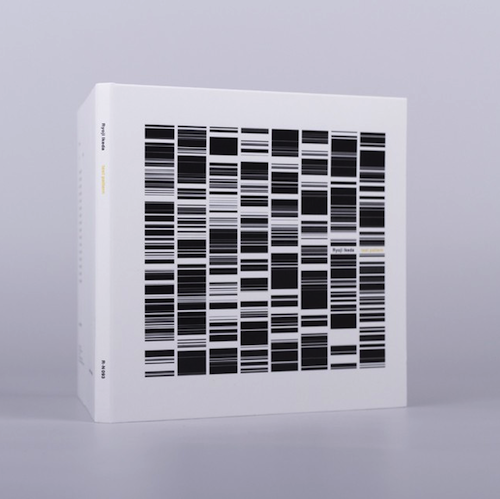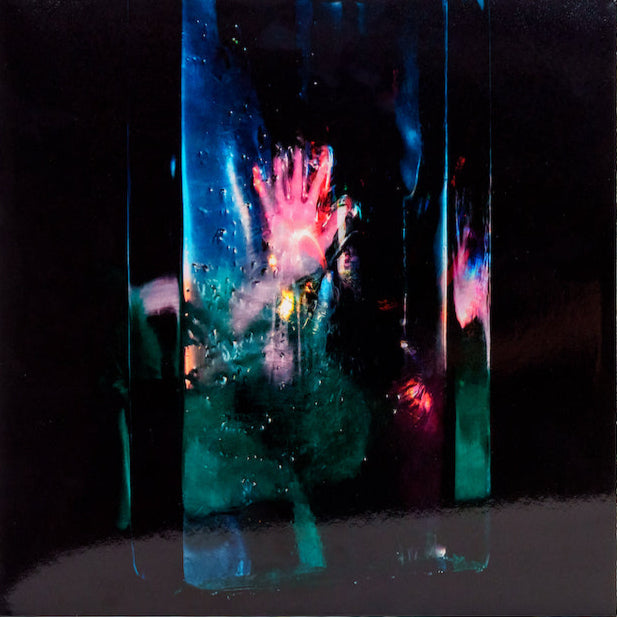
10 essential works on Carsten Nicolai’s Raster-Noton label

Over the past 16 years Raster-Noton has built itself up into one of the most distinctive and revered labels in electronic music. With co-founder Carsten Nicolai testing the limits of visual perception at his unicolor installation at Brewer Street Car Park this month, we take a look at the label through 10 ambitious and beautifully crafted releases.
Words: James Hammond
With a strong adherence to reductionism and taking raw materials down to their base elements, from packaging to the all-important sounds within, Raster-Noton is often referred to as genre in its own right. Describing what this genre-of-sorts entails as the number of releases has expanded beyond the 150 mark, normally resorts to the knee jerk labels of “glitch”, “academic” and “minimal techno” that have followed its sonic-aesthetic around. For founders Carsten Nicolai, Olaf Bender and Frank Brettschneider though, the most appropriate framing since inception is of an artist-run sonic space, a continually evolving “platform of music”. It’s certainly a platform that heralds high production values and incisive, conceptual explorations of sound.
Having all grown up in the cultural isolation of the East German industrial town of Chemnitz, the three soon became known to each other within a micro-climate of electronic music, which had its roots in pushing the sonic boundaries that were once so rigidly inflicted upon them by the state. Initial releases ran in parallel between Bender and Brettschneider’s Rastermusic and Nicolai’s noton archiv, before the merging of names came about in 1999, and at present the label is run between Berlin and Chemnitz. The label’s work with conceptual series as well as individual artist releases has made for an expansive back catalogue, which whilst having a certain degree of uniformity still revels in its variation and experimentation. It’s from this notion that the following list of essential RN listening emerges.

Various Artists
The 20′ To 2000 Series
(noton.archiv für ton und nichtton, 1999)
Asking 12 artists to record 20 minutes each in response to the last 20 minutes of the millennium, the series that resulted is an education in contemporary experimental electronics. Eventually compiled as a much sought after compilation box, if there ever were a Raster-Noton desert island collection this is it. Musically, conceptually, logistically and in terms of the minimalist design (the first use of clear scalloped CD Shell / ‘transport module’) they nailed it here. With efforts from the label founders and other visionaries such as Wolfgang Voigt, Mika Vainio, Ryoji Ikeda and Coil – the music is astounding and created a clear sonic palette and modus operandi for the label that they carried forward into the 21st century.

Alva Noto
Xerrox (Volumes 1-3)
(Raster-Noton, 2007 / 2009 / 2015)
Carsten Nicolai’s output has proven vast, and from exhibition to live performance to record, it is all part of a unified and distinctive approach. Whilst his ideas and sonic archive have been proliferated throughout the label and under different guises, his Xerrox series as Alva Noto deserves particular attention as remarkable works of ambience and sonic obfuscation. Using his own custom designed software to copy and reprocess sounds, he has so far created three volumes of deeply textured work with a decidedly emotive and melancholic edge. After a five year break the “towards space” theme of volume 3 appeared this year and is already a firm contender for the end of year lists. One for the ambient lovers.

SND
Atavism
(Raster-Noton, 2009)
2009’s Atavism full length presented us with SND at their most stripped back and elemental; a keenly focused study in repetition, nuance and sublime production work that still stands as the pinnacle of Mark Fell and Mat Steel’s collaborative project. The Sheffield duo have become synonymous with getting the most out of limited means, from equipment used to musical notions explored, and here the focus on what initially appears as a limited spectrum of repetitive mechanic percussion, becomes utterly beguiling as subtle changes in parameter reveal all manner of tonality and possibility in a truly compelling 60 minutes of sound.
The release appeared on both CD and 4GB SDHD card, with the latter again reflecting the label’s commitment to precision, fidelity and appropriate format, as the card allows for files to be streamed at 24bits and 96khz – unobtainable from a CD. Any meaningful discussion of the RN back catalogue isn’t complete without a mention of this extraordinary work of electronic music.

Atom™
HD
(Raster-Noton, 2013)
Along with its inherent “poppiness”, there’s a sense of the absurd and the humorous at work with HD (standing for Hard Drive rather that High-Def), none of which being what you’d typically expect from the supposed sonic austerity of Raster-Noton. It speaks of the ‘evolving platform of music’ that the label heads strive for, and primarily of course of Uwe Schmidt’s aka Atom TM’s gleefully eclectic approach to experimental music.
Like many who work with the label, Schmidt developed within a ferment of electronic ideas in the early ’90s, which became collectively coined as ‘minimal techno’, but relocating to Santiago, Chile to escape such genre specifics, Schmidt has a refreshing take on electronics in whichever guise he’s operating under. HD and other releases for Raster-Noton are suitably unique – a cover of The Who’s ‘My Generation’ on a Raster-Noton release? Roger Daltrey’s stutter as glitch electronics? Have a listen and all will become clear. A true highlight of recent releases that straddles an intriguing line between the readily listenable and the conceptual.

Various Artists
The Unun Series
(Raster-Noton)
The most recent series from the label has focused on 12” records organized conceptually with the periodic tables’ current frontier of discovery – the Unun elements (numbers 111 to 119). On record the science seems to have translated into a collection which is decidedly dance floor oriented, but being Raster Noton, this is of course a dance floor which values unpredictability and experimentation over convention. With the penultimate release issued this past March and the last part of the puzzle on its way, it’s proven a series with more than a few highlights. The curious should head straight for the NHK, Mika Vainio or Ueno Masaaki releases for a taste of what’s it’s all about.

Ryoji Ikeda
Dataplex
(Raster-Noton, 2005)
Ikeda’s relationship with Raster-Noton has proven a natural and fruitful one, with both label and artist keenly matched in their exploration of art and science, and the reduction and refinement of raw materials to their essence. With Dataplex the focus is on something Ikeda has become one of the most astute practitioners of: ways of presenting the raw material of data as sound. Ranging from harsh digital noise and high frequency permutations, to the combination of data.vortex/data.matrix where it feels as if the raw data has been bent to a musical will, this is a challenging, oft austere, yet conceptually profound listen.

Byetone
Death of a Typographer
(Raster-Noton, 2008)
Label founder Olav Bender has delivered a wide range of works for the label, with Death of a Typographer under his Byetone guise being one its most dance floor centric and melodic, particularly in contrast to the austere tones of his contribution to the 20-2000 series. With more than a few techno driven delights within, it’s a good entry point for those finding themselves a little apprehensive of the less easily digestible Raster-Noton releases. Bender is also a skilled designer and largely responsible for the labels striking minimalist designs and packaging. From transparent CDs to anti-static bags and choice of appropriate mediums for releases – from vinyl to memory sticks – it’s not just their own music that Bender and co. have paid the closest attention of detail to.

William Basinski
Shortwavemusic
(noton.archiv für ton und nichtton, 1998)
This is certainly one from the label’s broader palette and takes things back to 1998 and the earliest releases when Bender and Brettschneider’s Rastermusic were releasing in tandem with Nicolai’s noton.archiv. With Basinski now having become a renowned figure for analogue haze and deeply melancholic tape loops, the oft associated digital/clinical leanings of Raster-Noton might appear an unusual fit. However, the experimentation of this one and subsequent RN release ‘The River’ sits assuredly within the label’s ideals and indeed finds common ground with Alva Noto’s ambient majesty. It was Carsten Nicolai who insisted that Basinski, who was little known at the time, did more for his music archive and the tapestry of altered radio samples that form this LP acted as a first release and key step in the opening of Basinski’s vault of masterful tape works.

Frank Bretschneider
Rhythm
(Raster-Noton, 2007)
The third part of the label-head triptych on this list, Frank Bretschneider, like Nicolai and Bender, has put out several works on Raster-Noton, with Rhythm being one of his and the label’s most remarkable. Under the Komet alias and in recordings for other labels such as 12k and Mille Plateau, Bretschneider has become renowned for the inherent groove and funkiness of his interwoven electronics, and here the focus of this approach is, as the title would have it, on rhythm. Whilst the experimentation and complexities of his rhythm are wholly suited to the Raster-Noton ethos, they’re not at the sake of an emphatic musicality.

CoH And Cosey Fanni Tutti
CoH Plays Cosey
(Raster-Noton, 2008)
A key member of the Raster-Noton artist collective, Russian born Ivan Pavlov aka CoH turned out one of the oddest gems of the label’s catalogue in collaboration with the inimitable Cosey Fanni Tuttti (of Throbbing Gristle, Coum etc). The concepts the two dealt with here were “honesty, trust, privacy, communication, as well as the perception of sexuality” through the manipulation of Cosey’s correspondence with Pavlov. This correspondence entailed a series of vocal recordings made in “intensely emotional states” which create a surreal and sexually charged atmosphere when Pavlov edits them into his sound world to effectively “play” Cosey.
Carsten Nicolai’s unicolor runs until 2nd August at Brewer Street Car Park. Open daily (closed Monday) 12pm – 6pm. Entry free. Click here for more info.
Carsten Nicolai has also released a limited edition fluoro pink vinyl Random Groove under his noto moniker to mark the exhibition, featuring a selection of random grooves. Order your copy here.









